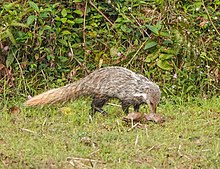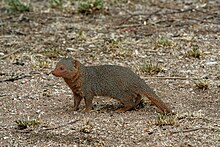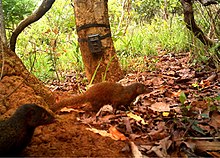Mungosi (porodica)
| Mungosi[1] | |
|---|---|

| |

| |
| razni predstavnici porodice Herpestidae | |
| Naučna klasifikacija | |
| Domen: | Eukaryota |
| Carstvo: | Animalia |
| Tip: | Chordata |
| Klasa: | Mammalia |
| Red: | Carnivora |
| Podred: | Feliformia |
| Infrared: | Aeluroidea |
| Parvred: | Viverroidea |
| Natporodica: | Herpestoidea |
| Porodica: | Herpestidae Bonaparte, 1845 |
| Tipski rod | |
| Herpestes Illiger, 1811
| |
| Potporodice | |

| |
| rasprostranjenost porodice | |
| Sinonimi | |
|
lista sinonima:
| |
Mungosi (lat. Herpestidae) porodica su iz podreda mačkolikih životinja. Naseljavaju kontinentalnu Afriku i južnu Evroaziju. Ova porodica je trenutno podeljena na dve potfamilije, Herpestinae i Mungotinae. Herpestinae obuhvata 23 žive vrste koje su poreklom iz južne Evrope, Afrike i Azije, dok Mungotinae obuhvata 11 vrsta koje potiču iz Afrike. Madagaskarski mungosi iz potporodice Galidiinae, koja je endemit Madagaskara, su se sa afroazijskim mungosima nalazili u istoj porodici. Međutim, nakon analiza DNK su smešteni u porodicu Eupleridae. Porodica Herpestidae je nastala pre oko 21,8 ± 3.6 miliona godina godina u ranom miocenu i genetski se razišla u dve glavne genetske loze pre 19.1 i 18,5 ± 3.5 miliona godina.
Pretpostavlja se da postoji bliska srodnost između cibetki i mungosa.
Na ostrva južnog Jadrana mungos je naseljen početkom 20. veka.
Jedna od bolje proučenih vrsta iz ove porodice su merkati (lat. Suricata suricatta). Oni su nastanjeni u Južnoj Africi i u polupustinjskim predelima. Domoroci ih nazivaju „čovečuljcima”. Žive u podzemnim staništima, u većim grupama.[2][3]
Etimologija naziva[uredi | uredi izvor]
Naziv ove porodice vodi porijeklo od tipskog roda Herpestes i taksonomski nastavka -idae. Engleska reč "mangus" se pisala kao "mungos" u 18. i 19. veku. Ime je izvedeno od naziva koji se u Indiji koristi za vrste Herpestes[4][5][6][7]: muṅgūs ili maṅgūs na klasičnom hindiju;[8] muṅgūs na marathiju;[9] mungisa na telugu;[10] mungi, mungisi and munguli na kanadski jezik.[11]
Opis[uredi | uredi izvor]
Mungosi su dugački do jednog metra zajedno sa repom (24 do 58 cm bez repa). Oni teže od 320 g do 5 kg.[12] Mungosi imaju duga lica i tela, male okrugle uši, kratke noge, i duge šiljate repove. Svoje neuvlačeće kandže koriste se prvenstveno za kopanje. Mungosi, poput koza, imaju uske, ovularne zenice. Većina vrsta ima veliku analnu mirisnu žlezdu koja se koristi za teritorijalno obeležavanje i signalizaciju reproduktivnog statusa. Zubna formula mangosa je 3.1.3–4.1–23.1.3–4.1–2.
Mungos je hitar je i neumoljiv: uporan je i nikada ne ostavlja svoj plen. Mungos je najpoznatiji neprijatelj strašne i opasne kobre. Bez straha joj se suprostavlja i iz dvoboja sa njom obično izlazi kao pobednik. Mungos vešto i hitro izbegava otrovne zube zmije sve dok ona ne skoči na njega. Tada mungos uspeva da je zgrabi za potiljak. Zaštićen je svojom debelom kožom i krznom. Egipatski mungos je bio sveta životinja u doba faraona, pa su u piramidama pronađene i mumije mungosa. Mnoge vrste mungosa žive pored čoveka, kako korisne kućne životinje koje uništavaju pacove i zmije, iako ponekad napadaju i domaće životinje — kuniće i živinu.
Mungosi imaju receptore za acetilholin koji su, poput receptora kod zmija, olikovani tako da se zmijski neurotoksin iz venoma ne može vezati za njih. Mungosi su jedan od četiri poznata taksona sisara sa mutacijama u nikotinskom acetilholinskom receptoru koje ih štite od zmijskog venoma.[13] Njihovi modifikovani receptori sprečavaju vezivanja α-neurotoksina iz zmijskog otrova. Ovi receptori imaju četiri zasebne, nezavisne mutacije. Kod mungosa, ova promena je dovodi do jedinstvene glikozilacije.[14]
Sistematika[uredi | uredi izvor]
Herpestina je bilo naučno ime koje je predložio Šarl Lusjen Bonaparta 1845. godine, koji je smatrao da su mungosi potporodica porodice Viverridae.[15] Godine 1864, Džon Edvard Grej je klasifikovao mungose u tri potfamilije: Galiidinae, Herpestinae i Mungotinae.[16] Ovo grupisanje je podržao Redžinald Pokok 1919. godine, koji je nazivao familiju Mungotidae.[17]
Genetička istraživanja bazirana na analizama jedrene i mitohondrijske DNK pokazala su da su Galidiines srodniji sa madagaskarskim mesožderima, uključujući fosu i fanaloku.[18][19] Galiidinae se trenutno smatra potfamilijom familije Eupleridae.[20]
| Podporodica | Rod | Vrste | Slika tipske vrste |
|---|---|---|---|
| Herpestinae | Herpestes Illiger, 1811[21] |
|

|
| Atilax Cuvier, 1826[27] | Močvarni mungos (A. paludinosus) (Cuvier, 1829)[28] | 
| |
| Cynictis Ogilby, 1833[29] | Žuti mungos (C. penicillata) (Cuvier, 1829)[28] | 
| |
| Urva Hodgson, 1836[30] |
|

| |
| Ichneumia Geoffroy Saint-Hilaire, 1837[36] | Belorepi mungos (I. albicauda) (Cuvier, 1829)[28] | 
| |
| Bdeogale Peters, 1850[37] |
|

| |
| Rhynchogale Thomas, 1894[43] | Melerov mungos (R. melleri) Gray, 1865[16] | 
| |
| Paracynictis Pocock, 1916 | Selusov mungos (P. selousi) (de Winton, 1896) | 
| |
| Xenogale Allen, 1919[44] | Dugonosi mungos (X. naso) (de Winton, 1901)[45] | 
| |
| Mungotinae | Mungos Etjen Žofroa Sent Iler & F. Cuvier, 1795[46] |
|

|
| Suricata Desmarest, 1804[49] | Merkat (S. suricatta) (Schreber, 1776)[50] | 
| |
| Crossarchus Cuvier, 1825 |
|

| |
| Helogale Gray, 1861 |
|

| |
| Dologale Thomas, 1920 | Puzargov mungos (D. dybowskii) Pousargues, 1894[51] | 
| |
| Liberiictis kuhni Hayman, 1958 | Liberijski mungos (L. kuhni) Hayman, 1958 |
Klasifikacija[uredi | uredi izvor]
Klasifikacija porodice Herpestidae:
[† - oznaka za izumrli takson]
- Porodica: Herpestidae
- Rod: †Kichechia
- Rod: †Legetetia
- †Legetetia nandii
- Rod: †Ugandictis
- †Ugandictis napakensis
- Potporodica: Herpestinae
- Rod: Atilax
- Atilax paludinosus (močvarni mungos)
- †Atilax mesotes
- Rod: Bdeogale
- Podrod: Bdeogale
- Bdeogale crassicauda (čuporepi mungos)
- Podrod: Galeriscus
- Bdeogale jacksoni (Džeksonov mungos)
- Bdeogale nigripes (crnonogi mungos)
- Podrod: Bdeogale
- Rod: Cynictis
- Cynictis penicillata (žuti mungos)
- Rod: Galerella
- Galerella flavescens (angolski vitki mungos)
- Galerella nigrata (crni mungos)
- Galerella ochracea (somalijski vitki mungos)
- Galerella pulverulenta (mali sivi mungos)
- Galerella sanguinea (vitki mungos)
- †Galerella debilis
- †Galerella palaeoserengetensis
- Rod: Herpestes
- Herpestes brachyurus (kratkorepi mungos)
- Herpestes edwardsi (indijski sivi mungos)
- Herpestes fuscus (indijski smeđi mungos)
- Herpestes javanicus (mali indijski mungos)
- Herpestes semitorquatus (grlasti mungos)
- Herpestes smithii (rumeni mungos)
- Herpestes urva (mungos rakojed)
- †Herpestes alaylaii
- †Herpestes lemanensis
- Rod: "Herpestes" <---[još neimenovan rod]
- "Herpestes" ichneumon (egipatski mungos)
- Rod: "Herpestes" <---[još neimenovan rod]
- "Herpestes" vitticollis (prugastovrati mungos)
- Rod: Ichneumia
- Ichneumia albicauda (bjelorepi mungos)
- †Ichneumia nims
- Rod: Paracynictis
- Paracynictis selousi (Selusov mungos)
- Rod: Rhynchogale
- Rhynchogale melleri (Melerov mungos)
- Rod: Xenogale
- Xenogale naso (dugonosi mungos)
- Rod: †"Herpestes" <---[još neimenovan rod]
- Rod: †Leptoplesictis
- †Leptoplesictis aurelianensis
- †Leptoplesictis mbitensis
- †Leptoplesictis namibiensis
- †Leptoplesictis rangwai
- †Leptoplesictis senuitae
- Rod: Atilax
- Potporodica: Mungotinae
- Rod: Crossarchus (kusimans)
- Crossarchus alexandri (Aleksanderov kusimans)
- Crossarchus ansorgei (angolski kusimans)
- Crossarchus obscurus (obični kusimans)
- Crossarchus platycephalus (ravnoglavi kusimans)
- †Crossarchus transvaalensis
- Rod: Dologale
- Dologale dybowskii (Puzargov mungos)
- Rod: Helogale (patuljasti mungos)
- Helogale hirtula (etiopski patuljasti mungos)
- Helogale parvula (obični patuljasti mungos)
- †Helogale kitafe
- †Helogale palaeogracilis
- Rod: Liberiictis
- Liberiictis kuhni (liberijski mungos)
- Rod: Mungos (mungos)
- Mungos gambianus (gambijski mungos)
- Mungos mungo (prugasti mungos)
- †Mungos dietrichi
- †Mungos minutus
- Rod: Suricata (merkat)
- Suricata suricata (merkat)
- †Suricata major
- Rod: Crossarchus (kusimans)
Filogenetsko stablo[uredi | uredi izvor]
Dolje prikazan kladogram predstavlja filogenetske veze porodice mungosi.
| Herpestoidea |
| ||||||||||||||||||||||||||||||||||||||||||||||||||||||||||||||||||||||||||||||||||||||||||||||||||||||||||||||||||||||||||||||||||||||||||||||||||||||||||||||||||||||||||||||||||||||||||||||||||||||||||||||||||||||||||||||||||||||||||||||||||||||||||||||||||||||||||||||||||||||||||||||||||||||
Galerija[uredi | uredi izvor]
Vremenska rasprostranjenst[uredi | uredi izvor]

Vidi još[uredi | uredi izvor]
Reference[uredi | uredi izvor]
- ^ Wozencraft, W.C. (2005). „Order Carnivora”. Ur.: Wilson, D.E.; Reeder, D.M. Mammal Species of the World: A Taxonomic and Geographic Reference (3rd izd.). Johns Hopkins University Press. str. 562—571. ISBN 978-0-8018-8221-0. OCLC 62265494.
- ^ Vaughan, Terry A.; James M. Ryan; Nicholas J. Czaplewski (2010). Mammalogy. Jones & Bartlett Learning. ISBN 978-0-7637-6299-5. str. 300.
- ^ Forsyth, Mark (2. 10. 2012). The Etymologicon: A Circular Stroll Through the Hidden Connections of the English Language. Penguin Publishing Group. str. 77—. ISBN 978-1-101-61176-0.
- ^ Valentini, M.B.; Major, J.D. (1714). „Viverra Indica grysea. Mungos”. Museum museorum, oder, Vollständige Schau Bühne aller Materialien und Specereyen. 2 Appendix IX. Franckfurt am Mayn: Johann David Zunners Sel. Erben, und Johann Adam Jungen. str. 24.
- ^ Jerdon, T.C. (1874). „127. Herpestes griseus”. The mammals of India; a natural history of all the animals known to inhabit continental India. London: J. Wheldon. str. 132—134.
- ^ Sterndale, R.A. (1884). „Herpestidae. The Ichneumon or Mungoose Family”. Natural history of the Mammalia of India and Ceylon. Calcutta: Thacker & Spink. str. 222—228.
- ^ Lydekker, R. (1894). „XIII. The Mungooses. Genus Herpestes”. A hand-book to the Carnivora. Part 1: Cats, civets, and mungooses. London: Edward Lloyd Limited. str. 244—269.
- ^ Platts, J.T. (1884). „منگوس मुंगूस muṅgūs, or मंगूस maṅgūs. The Mongoose, or ichneumon, Viverra ichneumon”. A dictionary of Urdu, classical Hindi, and English. London: W. H. Allen & Co. str. 1081.
- ^ Molesworth, J. T. (1857). „मुंगूस muṅgūsa, Bengal Mungoose, Viverra Ichneumon, or Herpesteus Griseus”. A dictionary, Marathi and English (Second, revised and enlarged izd.). Bombay: Printed for Government at the Bombay Education Society's Press. str. 384. Arhivirano iz originala 30. 1. 2021. g. Pristupljeno 5. 4. 2020.
- ^ Brown, C.P. (1903). „ముంగి or ముంగిస mungi. The ichneumon or mongoose, a kind of weasel. Viverra ichneumon”. A Telugu-English dictionary (New, thoroughly revised and brought up to date second izd.). Madras: Promoting Christian Knowledge. str. 997.
- ^ Reeve, W.; Sanderson, D. (1858). „ಮುಂಗಿ, ಮುಂಗಿಸಿ, ಮುಂಗುಲಿ”. A dictionary, Canarese and English (Revised, corrected and enlarged izd.). Bangalore: Wesleyan Mission Press. str. 787.
- ^ Macdonald, D., ur. (2009). The Encyclopedia of Mammals. Oxford: Oxford University Press. str. 660. ISBN 978-0-19-956799-7.
- ^ Barchan, D.; Kachalsky, S., Neumann, D., Vogel, Z., Ovadia, M., Kochva, E. and Fuchs, S. (1992). „How the mongoose can fight the snake: the binding site of the mongoose acetylcholine receptor” (PDF). Proceedings of the National Academy of Sciences. 89 (16): 7717—7721.
- ^ Drabeck, D. H.; Dean, A. M.; Jansa, S. A. (2015). „Why the honey badger don't care: Convergent evolution of venom-targeted nicotinic acetylcholine receptors in mammals that survive venomous snake bites”. Toxicon. 99: 68—72. PMID 25796346. doi:10.1016/j.toxicon.2015.03.007.
- ^ Bonaparte, C. L. (1845). „Fam. VII. Viverridae”. Catalogo Methodico dei Mammiferi Europei. Milan, Italy: L. di Giacomo Pirola. str. 8.
- ^ a b Gray, J.E. (1865). „A revision of the genera and species of viverrine animals (Viverridae) founded on the collection in the British Museum”. Proceedings of the Zoological Society of London: 502—579.
- ^ Pocock, R. I. (1919). „The classification of mongooses (Mungotidae)”. The Annals and Magazine of Natural History. 9 (3): 515–524.
- ^ Yoder, A. D.; Burns, M. M.; Zehr, S.; Delefosse, T.; Veron, G.; Goodman, S. M.; Flynn, J. J. (2003). „Single origin of Malagasy carnivora from an African ancestor”. Nature. 421 (6924): 434—437. PMID 12610623. doi:10.1038/nature01303.
- ^ Flynn, J. J.; Finarelli, J.; Zehr, S.; Hsu, J.; Nedbal, M. (2005). „Molecular phylogeny of the Carnivora (Mammalia): Assessing the Impact of Increased sampling on resolving enigmatic relationships”. Systematic Biology. 54 (2): 317—337. PMID 16012099. doi:10.1080/10635150590923326.
- ^ Wilson, D.E.; Reeder, D.M., ur. (2005). Mammal Species of the World: A Taxonomic and Geographic Reference (3rd izd.). Johns Hopkins University Press. ISBN 978-0-8018-8221-0. OCLC 62265494.
- ^ Illiger, C. (1815). „Überblick der Säugethiere nach ihrer Verteilung über die Welttheile”. Abhandlungen der Königlichen Preußischen Akademie der Wissenschaften zu Berlin. 1804−1811: 39−159. Arhivirano iz originala 4. 4. 2019. g. Pristupljeno 28. 12. 2019.
- ^ Linnaeus, C. (1758). „Viverra ichneumon”. Caroli Linnæi Systema naturæ per regna tria naturæ, secundum classes, ordines, genera, species, cum characteribus, differentiis, synonymis, locis. Tomus I (Decima, reformata izd.). Holmiae: Laurentius Salvius. str. 41. Šablon:In lang
- ^ Rüppell, E. (1835). „Herpestes sanguineus. Rüppell”. Neue Wirbelthiere zu der Fauna von Abyssinien gehörig. Frankfurt am Main: S. Schmerber. str. 27—28.
- ^ Wagner, J.A. (1839). „Über die Verwandtschafts-Verhältnisse der Pharaonsratte”. Gelehrte Anzeigen der Königlich Bayerischen Akademie der Wissenschaften zu München. 9 (183): 425—429.
- ^ Gray, J.E. (1848). „Description of a new species of Herpestes, from Abyssinia”. Proceedings of the Zoological Society of London (November): 138—139.
- ^ Bocage, J.V.B. (1889). „Mammifère d'Angola et du Congo”. Jornal de Sciencias mathematicas, physicas e naturaes. 2. 1: 174—185.
- ^ Cuvier, F. G. (1826). „Vansire”. Ur.: E. Geoffroy Saint-Hilaire; Cuvier, F. G. Histoire Naturelle des Mammifères: avec des figures originales, coloriées, dessinées d'aprèsdes animaux vivans. Tome 5. Paris: A. Belin. str. LIV.
- ^ a b v Cuvier, G. (1829). „Les Mangoustes. Cuv. (Herpestes, Illiger)”. Le règne animal distribué d'après son organisation, pour servir de base à l'histoire naturelle des animaux et d'introduction à l'anatomie comparée. Paris: Chez Déterville. str. 157—158.
- ^ Ogilby, W. (1833). „Characters of a new Genus of carnivorous Mammalia from the collection of Mr. Steedman”. Proceedings of the Zoological Society of London (Part 1): 48—49.
- ^ a b v Hodgson, B. H. (1836). „Synoptical description of sundry new animals, enumerated in the Catalogue of Nepalese Mammals”. Journal of the Asiatic Society of Bengal. 5: 231—238.
- ^ a b Geoffroy Saint-Hilaire, É. (1817). „De l'Ichneumon. Ichneumon pharaon”. Ur.: Jomard, E. F. Description de l'Égypte, ou, Recueil des observations et des recherches qui ont été faites en Égypte pendant l'éxpédition de l'armée française. Tome II. Paris: Commission des Sciences et Arts d'Egypte. str. 137—144.
- ^ Bennett, E. T. (1835). „Remarks on some Mammalia from Travancore, including a New Species of Herpestes”. Proceedings of the Zoological Society of London. III: 66—67.
- ^ a b Gray, J. E. (1837). „Description of some or little known Mammalia, principally in the British Mueum Collection”. The Magazine of Natural History and Journal of Zoology, Botany, Mineralogy, Geology and Meteorology. I (November): 577—587.
- ^ Waterhouse, G. R. (1838). „On two new species of Mammalia, from the Society's collection, belonging to the genera Gerbillus and Herpestes”. Proceedings of the Zoological Society of London. VI: 55—56.
- ^ Gray, J.E. (1846). „New species of Mammalia”. The Annals and Magazine of Natural History; Zoology, Botany, and Geology. 18 (118): 211—212.
- ^ Geoffroy Saint-Hilaire, I. (1837). „Notices sur deux nouveaux genres de Mammifères carnassiers, les Ichneumies, du continent Africain, et les Galidies de Madagascar”. Annales des Sciences Naturelles. 2. 8: 249—252.
- ^ Peters, W. (1850). „Bdeogale”. Sitzungsberichte der Gesellschaft Naturforschender Freunde zu Berlin: 94.
- ^ Peters, W. (1852). „Mittheilung über die in Mossambique beobachteten Mangusten”. Verhandlungen der Königlich Preussischen Akademie der Wissenschaften zu Berlin: 81—82.
- ^ Pucheran, J.P. (1855). „Les Mammifères de la côte occidental d'Afrique”. Revue et magasin de zoologie pure et appliquée. 2. 7: 111.
- ^ Thomas, O. (1894). „On a new African Genus of Mustelidae”. The Annals and Magazine of Natural History; Zoology, Botany, and Geology. 6. 13 (78): 522—524.
- ^ Heller, E. (1914). „New antelopes and carnivores from British East Africa”. Smithsonian Miscellaneous Collections. 61 (2240): 1—15.
- ^ Foley, C.; Do Linh San, E. (2016). „Bdeogale omnivora”. Crveni spisak ugroženih vrsta IUCN. IUCN. 2016: e.T136686A45221619.
- ^ Thomas, O. (1894). „On the mammals of Nyasaland: third contribution”. Proceedings of the Zoological Society of London (February): 136—146.
- ^ Allen, J. A. (1919). „Preliminary notes on African Carnivora”. Journal of Mammalogy. 1 (1): 23—31. JSTOR 1373716. doi:10.2307/1373716.
- ^ de Winton, W. E. (1901). „Description of a New Mongoose from West Africa”. Bulletin of the Liverpool Museums Under the City Council. 3 (2): 35—37.
- ^ Geoffroy, E.; Cuvier, F. (1795). „Mémoire sur une nouvelle division des Mammifères, et sur Ies principes qui doivent servir de base dans cette sorte de travail, lu à la société d'Histoire naturelle, le premier floréal de l'an troisième”. Ur.: Millin; Noel; Warens. Magasin Encyclopédique: ou journal des sciences, des lettres et des arts. Tome second. Paris: I'lmprimerie du Magazin Encyclopédique. str. 164—189.
- ^ Gmelin, J. F. (1788). „Viverra mungo”. Caroli a Linné, Systema naturae per regna tria naturae, secundum classes, ordines, genera, species, cum characteribus, differentiis, synonymis, locis. I (13th aucta, reformata izd.). Lipsiae: Georg Emanuel Beer. str. 84—85.
- ^ Ogilby, W. (1835). „Descriptions of Mammalia and Birds from the Gambia”. Proceedings of the Zoological Society of London. Part III: 97—105.
- ^ Desmarest, A. G. (1804). „Genre Surikate, Suricata Nob.”. Ur.: Deterville, J. F. P. Nouveau dictionnaire d'histoire naturelle appliquée aux arts: principalement à l'agriculture et à l'économie rurale et domestique. 24. Paris: Deterville. str. 15.
- ^ Schreber, J. C. D. (1776). „Viverra suricata”. Die Säugethiere in Abbildungen nach der Natur, mit Beschreibungen. Erlangen: Expedition des Schreber'schen Säugthier- und des Esper'schen Schmetterlingswerkes. str. CVII.
- ^ de Pousargues, E. (1894). „Description d'une nouvelle espèce de mammifère du genre Crossarchus et considérations sur la répartition géographique des crossarques rayés”. Nouvelles Archives du Muséum d'Histoire Naturelle. 3 (na jeziku: francuski). 6: 121—134.
Literatura[uredi | uredi izvor]
- Macdonald, D., ur. (2009). The Encyclopedia of Mammals. Oxford: Oxford University Press. str. 660. ISBN 978-0-19-956799-7.
- Forsyth, Mark (2. 10. 2012). The Etymologicon: A Circular Stroll Through the Hidden Connections of the English Language. Penguin Publishing Group. str. 77—. ISBN 978-1-101-61176-0.
- Rasa, Anne (1986). Mongoose Watch: A Family Observed. Garden City, NY: Anchor Press/Doubleday & Co. ISBN 9780385231756. OCLC 12664019.
- Hinton, H. E. & Dunn, A. M. S. (1967). Mongooses: Their Natural History and Behaviour. Berkeley: University of California Press. OCLC 1975837.
Spoljašnje veze[uredi | uredi izvor]
- „Ichneumon”. Encyclopædia Britannica (на језику: енглески) (11 изд.). 1911.













